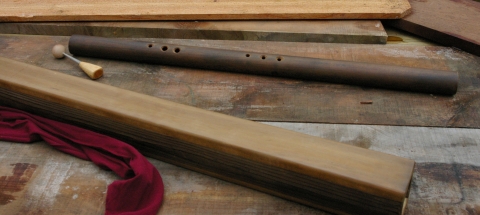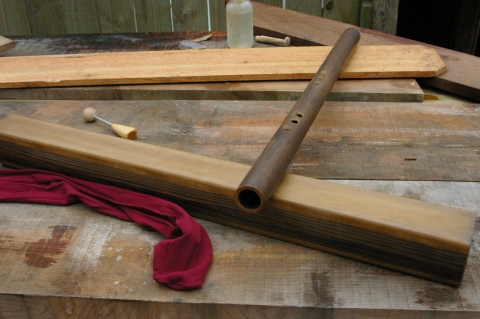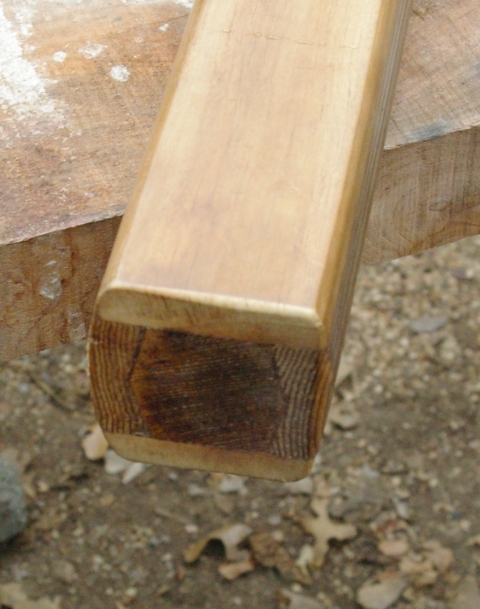I have an affection for Penny Whistles and Ocarinas. I also have a bit of a collection of these. My wife also loves these, but hates loud, high pitched noises.
So I decided to make a low Penny Whistle. Lots of odd research and equipment involved. Lots of skills to develop, and physics models to play with. It was a very fun project and it taught me quite a bit.
Of course I did not follow conventional form, instead I borrrowed and twisted and innovated a bit of my own. The result was quite well worth it.
About the innovations,
The fipple is on the opposite side of the flute from the finger holes and it presents on a corner.
This allows the instrument to be held closer to the body in a more natural pose.
The holes are grouped with the hands seperated and the holes skewed to make them a more natural grip.
The entire instrument is made from cedar and constists of only two parts. There is no glue holding the fipple in the bore.
The sound is to me, exquisite. Almost a pity for such a fine instrument to be kept by such a poor musician as myself.
The case is made of popular and cedar, with a milk paint finish.
The case has been through quite a bit, but has held up nicely.
Cedar is an ideal wood for an instrument. It breathes and does not expand much when damp. Flutes get damp.
This one project required developing skills and tool use outside of the use of a circular saw or table saw. It led me to another world that I am happy to now live in.
Bob





 A page Dedicated to My Writing
A page Dedicated to My Writing
I just started recently so it’s fresh in my mind. Although some of my first projects would maybe be classified as “DIY chores” of which I started many much earlier, these particular ones were done along my course to woodworking with hand tools.
I cut a scrap 2×4 into a two-piece articulated vehicle for my son. The pieces were cut and shaped with a coping saw, a hole saw, an auger bit, and a Unibit. The tools were all household type stuff — the two hole saws I used are the ones for installing a door knob for example.
Then I built a ramp so my wife could move a cart over the step down from the sliding glass door in the back. It doesn’t sound remarkable but I used a hand saw which for me was previously something I wouldn’t have considering using for more than a single small cut. A project like this would have required a power miter saw or at least a “Skil” saw. A mental barrier came down.
I built a very large 10′ workbench mostly out of 2×2 strips — many of them. I had really lost my sanity. I was going hand-saw crazy. That bench must have taken hundreds of cuts. I had a floor full of sawdust and there was no sound of power tools to be heard.
With the scrap from the workbench I made a few other projects. I walked into the shop one time with my baby in one arm and picked up the coping saw. I sawed out the shape of a guitar body with one hand and finished it with a 2×2 neck. My toddler loved it, so I built another one for him. After some refinement it had a bridge, saddle, copper electrical wire frets, tuning machines using brass eye-hooks, and was strung in tune.
Then, curiously, a built a about a half dozen whistles like yours — only mine were more crude having been started from 2×2 scrap. I bored them out with a really long spade bit. I used a 5/8″ auger bit to bore more precisely for the mouthpiece which I formed with a 5/8″ oak dowel. I ended up with one or two that worked ok.
For more serious minded work, I knew I needed to be more precise. My machine-minded thinking had determined I needed one of those sliding miter saws, but besides that I also needed flat, square stock so that meant a jointer and a thickness planer. But in my heart, the last thing I wanted was a machine shop.
I lamented what I perceived to be the inability to obtain a good hand miter saw which I thought was what I needed to bring precision to my work. Even imagining the best miter saw of this type I still had doubts it would be the solution.
Then I read about shooting boards. What’s this? Precision joints and miters with a hand plane? For me, this overcame the last mental barrier and banned machines from my shop (at least until my boys are old enough to use them).
I had tried pushing my dad’s hand plane across a board once maybe 25 years ago. It chattered, damaged the wood, and seemed worthless (it was in a worthless condition and I had no idea how to use it). My dad had never used it except maybe to trim the bottom of a door. I had written it off as an obscure tool with little application. Now I use (a good) one almost daily.
This is how I got started in saws, planes, and chisels — these are the fundamental tools with which I can do everything I want. Of course there are supplemental tools for layout and marking, sharpening, a chisel hammer for example — but I think saws, planes, and chisels are the fundamentals. With them we can go from rough lumber from the mill (or even saw our own), to fine furniture of the highest caliber. Everything else is basically a time saving contraption.
Don’t get me wrong though… there’s been times when I was halfway through resawing a plank when I questioned my sanity — or when I chipped a plane blade and looked at my extra coarse waterstone, realizing I would be set back a whole day because I had banned even a bench grinder. After days of planing piles of shavings just to obtain a few dimensioned components, I swore to myself I needed a jointer and thicknesser, but it was just a lack of patience.
Resawing and thickness planing are the two that make me question my sanity too. They can be a pain with hand or power tools.
Both of those tasks are strong reasons why a lot of woodworkers never become pure hand tool users.
Bob
No power jointers or planers around here. My power mitersaw sits unused, not too far away from the unused router table… no tablesaw, no drillpress, no lathe….
But I have 4 different sizes of rabbet planes and am acquiring moulding planes now.
I do confess to using powerdrills for quick’n dirty fence repairs.
My greatest handtool challenge so far – only one so far – in using handtools for DIY chore projects has been several 72″ long rips in old doug fir. I used a riptooth Japanese saw and it took forever. The cut quality was just fine though.
I since have acquired an old Disston low tpi rip that was already sharp – which solved that problem for me in softwoods. I don’t do long rips in hardwoods – yet….
Hmm.. maybe this should go in the slope thread???
Skip
I know this is an older post, but I just came to it from the Phat Fiber list and had to leave a comment. ;)) Here goes:
Awww, I love pennywhistles and ocarinas, too! I love musical instruments in general, but at one point I made a rule that if I was going to be crazy and start collecting instruments, they had to all be woodwinds for the time being. At least woodwinds *come* in less expensive but very playable varieties. Percussion instruments do, too, but I’m not really a percussion type … 😉
Lovely flute, anyway. I’ve never seen one made of cedar, but now I kind of want one. (Does it smell like a hamster cage? In a good way? ;))
Yes it does have the scent of cedar. Hard to find a flageolet in cedar, but Native American Flutes, in a sort of minor pentatonic scale, are available. http://www.native-languages.org/flutes.htm http://www.cedarflutes.com/
Since Native American Flutes are different from other flutes in their construction, it is possible for them to be made anywhere and still be called a Native American Flute. Personally I would hold out for a Native American, Native American Flute. 🙂
Bob